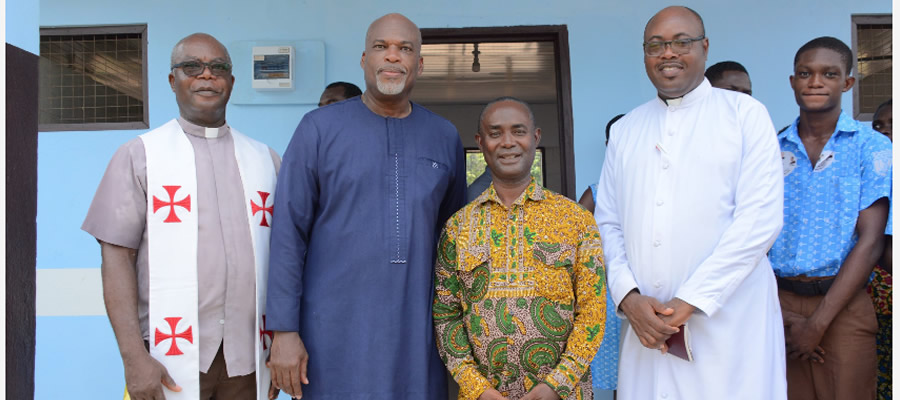

Introduction
The population size, composition and age-sex structure are important characteristics that have many social and economic implications of the welfare of the people. The population composition by age and sex influences fertility, mortality, migration and other demographic processes that underlie population growth and ultimately socio-economic development. This chapter discusses the population distribution by municipality, age, sex and locality. Also, it presents data on sex ratios, fertility and mortality levels.
Population Size and Distribution
As shown in table 2.1, Nsawam-Adogyiri Municipality recorded a population of 86,000, comprising 42,733 (49.7%) males and 43,267 (50.3%) females with the urban population (50,864) outnumbering that of the rural population. The density of the population is 465 persons per square kilometre.
Population distribution by age, sex and sex ratio
The cumulative computation from Table 2.1 shows that the number of males in the Municipality is higher (14,804) than that of the females (14703) in the age group 0 to 14years as well as among the 15-64 year-olds, 26,126 females as compared with 26,207. However, among those aged 65 years and above, the females (2, 438) outnumber the males (1,722).
The sex ratio (the number of males per 100 females) of the municipality stands at 98.8 percent which indicates predominance of females over males in the municipality. Also, it implies that for every 100 females there is a corresponding 98 males.
Age and Sex Structure
Table 2.1 also indicates the age structure by sex, age group and type of locality of Nsawam- Adoagyiri Municipality. From the table, majority (60.9%) of the population are within ages 15-64 years. This shows that the age structure of the population in the municipality is skewed towards the youth and economically active group. This is followed by age groups 0-14 years whiles the population within the age groups 65 years and older records the lowest.
The general pattern of the age and sex structure shows consistent decrease in the size of age groups with increasing age as can be seen for both sexes, from age 15-19 years and older. The age structure and the sex composition of the population of the municipality follow the regional pattern. Apart from the age group 65years and older where the females are slightly more than males, the male population outnumbers the female population in all the other age groups as indicated by the table. It is worth noting that in all the age groupings majority of the population live in the urban areas of the municipality.
Population pyramid
Figure 2.1 shows graphical presentation of age-sex structure of the municipality. The age structure is broad at the base and reduces gradually in the subsequent age groups until the population becomes relatively small at the top. It shows that a large new cohort is born every year as displayed at the bottom of the pyramid (ages 0-4 years). As cohorts age, they inevitably lose members either through death or migration or both. This is shown by the narrowing of the population at its peak another feature of the municipal population pyramid is that females in the oldest age groups form the substantial majority than the males.
Age-dependency ratio
The dependency ratio indicates the extent to which the number of young aged less than 15 years and older people (over 65) depend on people of the working age group (15 - 64 years.). Table 2.1 shows that the age dependency ratio for the Municipality is 64.3, which is lower than the regional dependency ratio of 82. The dependency ratio is higher in the rural areas (78.6) than in the urban areas (55.7). The female dependent ratio of 65.6 persons is higher than that of the Municipality. The males recorded 63.1 persons in the inactive population.
There is variation of the dependency ratio by sex, indicating that, for females in Nsawam Adogyiri Municipality, there are 65.6 persons in the dependent age groups for every 100 persons in the working ages whereas for males, there are 63.1 persons in the dependent age group for every 100 persons in the working ages.
Fertility, Mortality and Migration
Fertility, Mortality and Migration are principal determinants of population change at a particular point in time. The levels and changes of these three components of population- fertility, mortality and migration are important for socioeconomic planning and policy adoption.
In developing countries such as Ghana, where population registers are non-existent, censuses provide the more comprehensive data on fertility, mortality and migration in terms of coverage than surveys and other sources. Censuses, however, may not capture all aspects of the components of population as surveys do.
Fertility
Table 2.2 shows the total fertility rate, general fertility rate and crude birth rate by district and region. Out of the total population of 86,000 in the municipality, 22,241 are females between the ages of 15-49 years. There were 1,996 births in the last 12 months preceding the census in the Municipality. Total Fertility Rate (TFR) is the average number of children that would be born to a woman by the time she completes childbearing if she were to experience the prevailing age-specific fertility rate. There are other fertility measures such as Crude Birth Rate (CBR), General Fertility Rate (GFR) among others. The crude birth rate (CBR) is the simplest and most frequently used measure of fertility.
The Total Fertility Rate in the Municipality for women aged 15-49 years is 3.1 births per woman. This means that a woman in the municipality, on the average would have approximately 3 children in her lifetime. This however is lower than the regional average of 3.5 births per woman as well as districts such as Kwahu Afram Plains South Akyem Mansa, Kwahu East and which recorded the highest total fertility rates of 4.7, 4.3 and 3.8 births per woman respectively but higher than that of New Juaben Municipal (2.4 births per woman). The GFR of 89.7 and the CBR of 23.2 are both slightly lower than that of the region.
Mortality
Mortality is one of the three components of population change, which plays a vital role in determining the growth of the population. The level and pattern of mortality is a reflection of the health status of the population. Table 2.3 provides information on females aged 12 years and older e, children ever born, children surviving and sex of a child in the Municipality. The table shows that the number of children ever born to females’ aged 12 years and older in the Municipality is 71,393, out of which 62,536 children are surviving. The proportion of male
children ever born is higher (50.5%) than that of the female children ever born (49.8%). The situation however is different for children surviving where the proportion of female children surviving is slightly higher (50.5%) than that of the males (49.5%).
From the table, the proportion of female children ever born by females within the age group 35-39 years is slightly higher (12.0%) than that of the males (11.8%).The proportion of the surviving females is also slightly higher (12.7%) than that of males (12.5%).
Table 2.4 presents the total number of deaths and crude death rates in the district. Four hundred and forty-eight deaths were recorded at the household level out of a total population of 86,000.The crude death rate which measures the number of deaths per 1,000 populations is second lowest (5.2) after Kwahu Afram Plains (4.4) in the region. The municipal crude death rate of 5.2 per 1,000 is also lower than that of the region (8.2).
Migration
The importance of measuring migration lies in its impact on population size, structure and distribution in the region. Migration out of the district decreases the size of the population in the region, while migration into the district increases the population size. In addition, the variations in the migration process in terms of age, sex, education and other socio-demographic characteristics can have significant impact on the overall social and economic development of the district. Migration is difficult to measure due to its repetitiveness and difficulty in establishing direction and permanency of the event. Nevertheless, census information on usual place of residence five years before the census and current residence is used to discuss migration patterns in the district.
Out of the total population enumerated in the Municipality, 36,689 are migrants constituting 42.7 percent of the population as indicated by Table 2.5. There are 16,085 (43.8%) migrants born elsewhere in another region and 1,326 (3.6%) of the migrants residing in the Municipality are born outside Ghana. The table further shows that higher proportions of migrants (born elsewhere in other regions) that are in the Municipality are from Greater Accra (5,399) and Ashanti (2,942) Regions. The smallest number of migrants (those born elsewhere in other regions) is from the Upper West (276) and Upper East (464). In terms of duration of residence, the table further shows that majority of the migrants have been in the Municipality for (1-4 years). Upper East recorded 36.6 years, followed by Upper West 35.5 years and Northern 32.4 years.
Date Created : 11/27/2017 1:12:00 AM













 facebook
facebook
 twitter
twitter
 Youtube
Youtube
 +233 593 831 280
+233 593 831 280 0800 430 430
0800 430 430 GPS: GE-231-4383
GPS: GE-231-4383 info@ghanadistricts.com
info@ghanadistricts.com Box GP1044, Accra, Ghana
Box GP1044, Accra, Ghana